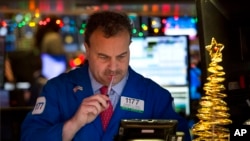U.S. stocks held on to slight gains Friday as they traded in a very narrow range on light volumes, struggling to find direction ahead of the long holiday weekend. Markets in the U.S. will be closed Monday in observance of Christmas.
Overall, investors appeared content to go into the final week of the year doing nothing, leaving capital gains tax selling until 2017 in hopes of seeing a lower tax rate under the new Trump administration.
"Investors are heavily incentivized to postpone any selling into 2017 to take advantage of the tax cuts under President-elect Trump," said Adam Sarhan, CEO of 50Park Investments. "The lack of selling is clearly seen in the major indices as they simply refuse to fall ever since the election. The Dow Jones industrial average had its seventh consecutive weekly gain. That clearly illustrates that sellers remain at bay."
Indeed, the Dow is up about 14 percent for the year and the S&P 500 is 11 percent higher following the national election November 8 on bets that the economy will benefit from Trump's plans for deregulation and infrastructure spending.
Another reason for range-bound trade is sector rotation versus fresh money coming into the market. For example, the financial sector has been strong since the national election. Goldman Sachs, one of the largest companies in the sector, is up 32 percent in just that time.
Utilities and telecoms, on the other hand, which were outperformers earlier in the year because investors were going to those sectors for dividends and income, have reversed their fortunes as money rotates out of there and into the financials and industrials.
Santa Claus rally
The last five trading days of the year and first two trading days of the new year are historically bullish for the equity markets, also known as the "Santa Claus rally." Analysts at LPL Financial said, "Going back to 1950, these seven days are up, on average, 1.4 percent and higher 77.3 percent of the time, as measured by the S&P 500. It is worth noting that Santa hasn't come the past two years, and this has led to weak January returns, down 3.1 percent and 5.3 percent, in 2015 and 2016, respectively."
Trading week ahead
The week between Christmas and New Year's Day is typically a quiet one for economic data and earnings, and next week’s calendar fits that pattern. In the U.S., reports on manufacturing in December from the Richmond and Dallas Federal Reserve Banks, reports on home prices and pending home sales, consumer confidence, the weekly report on initial jobless claims and the first look at the trade deficit in November are all on tap. There are no major central bank meetings or speakers scheduled for the U.S. or abroad.









